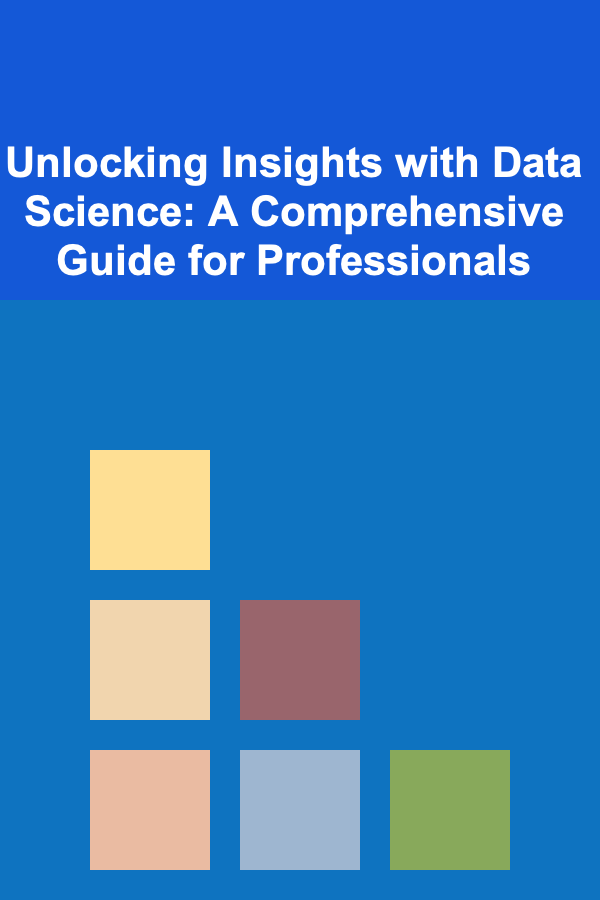
Unlocking Insights with Data Science: A Comprehensive Guide for Professionals
ebook include PDF & Audio bundle (Micro Guide)
$12.99$10.99
Limited Time Offer! Order within the next:

Data science has become one of the most essential fields in today's rapidly evolving digital world. With organizations generating vast amounts of data, the ability to unlock actionable insights is a powerful skill that can drive decision-making, improve business processes, and generate competitive advantages. Whether you're a seasoned data scientist or someone looking to dive deeper into the field, understanding how to convert raw data into strategic insights is crucial.
This comprehensive guide will take you through the essential steps in the data science process, highlighting best practices, key techniques, and tools to help professionals unlock the true potential of data.
Understanding Data Science: The Foundation of Insight Extraction
Data science is not merely about analyzing numbers. It's about understanding and extracting valuable knowledge from data in a way that informs decision-making and optimizes processes. The journey from data collection to actionable insights requires expertise in various areas, including:
- Data collection and preparation
- Exploratory data analysis (EDA)
- Statistical modeling and machine learning
- Data visualization and communication of insights
The Role of a Data Scientist
A data scientist's role is multi-faceted. The key responsibilities include:
- Problem Definition: Understanding the business problem and determining how data can help solve it.
- Data Acquisition and Cleaning: Collecting data from various sources, cleaning it to remove inconsistencies, and transforming it into a usable format.
- Data Exploration and Analysis: Analyzing data to uncover trends, patterns, and insights that can inform decision-making.
- Model Building and Validation: Developing statistical and machine learning models to make predictions or derive insights.
- Communication: Presenting the findings in a clear and actionable way for stakeholders to understand and act upon.
The Process of Unlocking Insights from Data
The process of turning raw data into valuable insights follows a systematic workflow, each step contributing to the final result. Here's an in-depth look at the process:
Step 1: Data Collection and Preparation
Before diving into any kind of analysis, data must be gathered from various sources. This could include databases, APIs, files, and external datasets. However, the data collected may not always be in a ready-to-analyze format. Thus, the first major task in data science is data preparation.
Key Tasks in Data Preparation:
- Data Integration: Combining data from different sources to create a unified dataset.
- Data Cleaning: Identifying and correcting errors such as missing values, inconsistencies, and outliers.
- Data Transformation: Converting data into formats suitable for analysis (e.g., encoding categorical variables, normalizing numerical data).
- Feature Engineering: Creating new features from the raw data that can help the model's performance. This could involve aggregating, scaling, or deriving new attributes.
Step 2: Exploratory Data Analysis (EDA)
Once the data is prepared, the next step is to explore the dataset to uncover underlying patterns. This phase, known as exploratory data analysis (EDA), is critical because it helps identify trends, anomalies, and relationships that could drive deeper analysis.
Key Techniques in EDA:
- Descriptive Statistics: Computing summary statistics like mean, median, standard deviation, and percentiles. This provides an overall understanding of the data.
- Data Visualization: Visualizing the data using charts and graphs such as histograms, box plots, scatter plots, and correlation matrices. These visual tools help reveal trends and outliers.
- Correlation Analysis: Using correlation coefficients (such as Pearson or Spearman) to identify relationships between variables.
- Dimensionality Reduction : For large datasets, reducing the number of variables while retaining essential information. Techniques like PCA (Principal Component Analysis) or t-SNE (t-Distributed Stochastic Neighbor Embedding) are commonly used.
Step 3: Building Predictive Models
Once the data is clean and explored, predictive modeling begins. This is the heart of data science, where you apply algorithms to uncover patterns or make predictions. The choice of model depends on the problem you're trying to solve.
Types of Predictive Models:
-
Supervised Learning : When the data contains labeled outcomes, supervised learning techniques such as linear regression , decision trees , and random forests can be used to predict future outcomes based on historical data.
- Classification: For predicting categorical outcomes (e.g., spam detection or customer churn).
- Regression: For predicting continuous outcomes (e.g., stock prices or sales forecasts).
-
Unsupervised Learning : When there are no labeled outcomes, unsupervised learning techniques such as k-means clustering or hierarchical clustering help identify patterns or groupings within the data.
-
Reinforcement Learning: A type of machine learning where models learn by interacting with an environment, receiving feedback, and optimizing performance. It's widely used in robotics and autonomous systems.
-
Deep Learning: Involves neural networks with many layers that are able to automatically learn features from the raw data, especially in complex tasks such as image recognition, natural language processing, and speech recognition.
Step 4: Model Validation and Evaluation
Once a model is built, it's crucial to validate its performance. This is done to ensure the model's reliability and generalization on unseen data. Model evaluation techniques such as cross-validation, accuracy scores, confusion matrices, and ROC curves are commonly used.
Key Model Evaluation Techniques:
- Cross-Validation: Splitting the data into multiple subsets (folds) to test the model on different parts of the data, ensuring it doesn't overfit.
- Confusion Matrix: For classification tasks, a confusion matrix provides insight into the number of true positives, true negatives, false positives, and false negatives.
- Precision, Recall, F1-Score: These metrics provide more nuanced evaluations for classification models, particularly when dealing with imbalanced datasets.
- Root Mean Square Error (RMSE): For regression tasks, RMSE is often used to measure how well the model's predictions match the actual outcomes.
Step 5: Communicating Insights
The final step is to communicate the findings in a way that stakeholders can understand and act upon. A good data scientist not only builds models but also translates their results into actionable insights.
Best Practices for Communicating Insights:
- Storytelling with Data: Present your findings as a story, connecting the insights to real-world business problems and outcomes.
- Visualizations : Use charts, graphs, and dashboards to present key insights clearly and concisely. Tools like Tableau or Power BI can help build interactive visualizations.
- Tailored Reporting: Adjust your communication style based on the audience. Executives might prefer high-level insights, while technical teams may require more in-depth analysis.
- Recommendations: Provide actionable recommendations that stakeholders can implement, such as strategies for improving customer retention or optimizing operations.
Advanced Techniques and Tools
While the steps outlined above form the core of data science, there are advanced techniques and tools that can help take your insights to the next level.
Advanced Techniques:
- Natural Language Processing (NLP): A branch of AI focused on the interaction between computers and human languages. Techniques like sentiment analysis, topic modeling, and text classification are essential for working with unstructured text data.
- Anomaly Detection: This involves identifying outliers or unusual patterns in the data, which could indicate fraud, system errors, or other significant events.
- Time Series Forecasting : For data that changes over time (e.g., sales data), techniques like ARIMA or exponential smoothing can be used to predict future values.
- Ensemble Learning : Combining multiple models to improve predictive performance. Methods such as bagging , boosting , and stacking are commonly used in ensemble learning.
Tools for Data Science:
- Python : One of the most popular languages for data science, Python provides libraries like Pandas , NumPy , Matplotlib , and Scikit-learn for data manipulation, analysis, and machine learning.
- R : Another powerful language for statistical analysis and data visualization, with libraries such as ggplot2 , dplyr , and caret.
- SQL: Essential for querying relational databases and working with large datasets.
- Cloud Platforms : Cloud computing services like AWS , Google Cloud , and Azure offer scalable computing power for processing large datasets and building complex models.
Conclusion: The Continuous Journey of Data Science
Unlocking insights from data is an ongoing journey, not a one-time task. As new data becomes available, the insights and models must be continuously refined to adapt to changing circumstances. The world of data science is vast and evolving, with new techniques, tools, and best practices emerging regularly.
For professionals looking to stay ahead in the field, the key is to continually build on foundational knowledge while embracing new advancements in machine learning, AI, and analytics. By following a structured process, using the right tools, and communicating insights effectively, data scientists can empower organizations to make data-driven decisions that propel success.

Creating Passive Income Streams with Automated Deep Learning Solutions
Read More
How to Continuously Improve Your Product Through Post-Launch Testing
Read More
How to Make an Eco-Friendly Recipe Book with Recycled Materials
Read More
How to Start an Antique Collection: A Beginner's Guide
Read More
How to Store Seasonal Clothing Efficiently in Small Closets
Read More
How to Use Music to Enhance the Atmosphere of Your Yard Sale
Read MoreOther Products

Creating Passive Income Streams with Automated Deep Learning Solutions
Read More
How to Continuously Improve Your Product Through Post-Launch Testing
Read More
How to Make an Eco-Friendly Recipe Book with Recycled Materials
Read More
How to Start an Antique Collection: A Beginner's Guide
Read More
How to Store Seasonal Clothing Efficiently in Small Closets
Read More